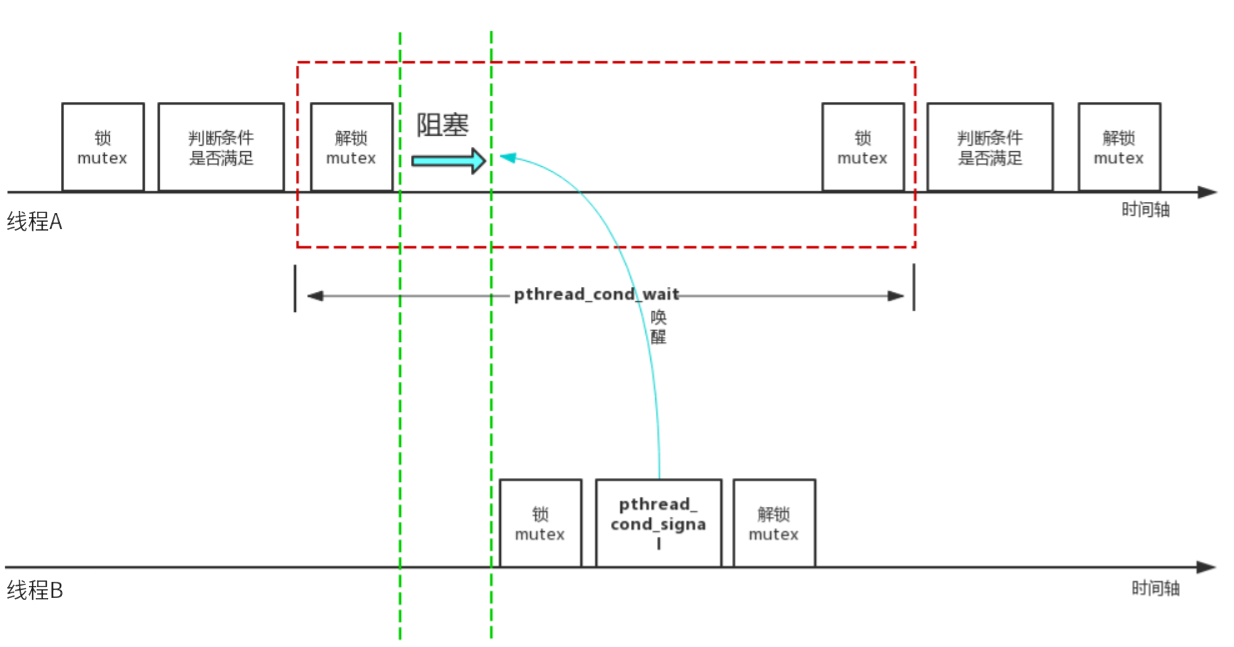知识点链接
https://www.yuque.com/aihenaobaijin/camuoq/lscmvf6z1arklau4?singleDoc# 《IO进程》
建议先学习知识点,再进行下面的练习
线程
概念
线程是一个轻量级的进程,为了提高系统的性能引入线程
线程和进程是参与统一的调度
在同一个进程中可以创建的多个线程,共享进程资源
线程资源
共享的资源:可执行的指令、静态数据、进程中打开的文件描述符、信号处理函数、当前工作目录、用户ID、用户组ID
私有的资源:线程ID (TID)、PC(程序计数器)和相关寄存器、堆栈(局部变量, 返回地址)、错误号 (errno)、信号掩码和优先级、执行状态和属性
练习:循环输入输出,quit结束
通过线程实现数据的交互,主线程循环从终端输入,线程函数将数据循环输出,当输入quit结束程序。
1)全局变量进行通信
2)加上标志位(flag),实现主线程输入一次,线程函数打印一次, int flag = 0;
#include <stdio.h>
#include <pthread.h>
#include <string.h>
char s[32];
int flag = 0; //为了进行线程间通讯,保证主线程先输入然后从线程再输出
void *handler_thread(void *arg)
{
while (1)
{
if (flag == 1) //主线程输入完将flag置1从线程再输出
{
if (strcmp(s, "quit") == 0)
break;
printf("%s\n", s);
flag--;
}
}
return NULL;
}
int main(int argc, char const *argv[])
{
pthread_t tid;
if (pthread_create(&tid, NULL, handler_thread, NULL) > 0)
{
perror("err");
return -1;
}
while (1)
{
//scanf前也可以不加if判断,利用阻塞时间让从线程输出
// if (flag == 0) //从线程输出完将flag置0主线程再输入
// {
scanf("%s", s);
flag++;
if (strcmp(s, "quit") == 0)
break;
// }
}
}同步
概念
同步(synchronization)指的是多个任务(线程)按照约定的顺序相互配合完成一件事情(异步:异步则反之,并非一定需要一件事做完再做另一件事)
同步机制
通过信号量实现线程间同步。
信号量:通过信号量实现同步操作;由信号量来决定线程是继续运行还是阻塞等待。
信号量代表某一类资源,其值表示系统中该资源的数量:
信号量的值>0, 表示有资源可以用, 可以申请到资源。
信号量的值<=0, 表示没有资源可以用, 无法申请到资源, 阻塞。
信号量还是一个受保护的变量,只能通过三种操作来访问:初始化、P操作(申请资源)、V操作(释放资源)
sem_init:信号量初始化
sem_wait:申请资源,P操作,如果没有资源可以用会阻塞等待,直到有资源可用结束阻塞资源-1。
sem_post:释放资源,V操作,非阻塞,资源+1。
练习:用信号量实现循环输入输出quit结束
#include <stdio.h>
#include <pthread.h>
#include <string.h>
#include <semaphore.h>
char s[32];
sem_t sem1; //信号量对象
sem_t sem2;
void *handler_thread(void *arg)
{
while (1)
{
//申请资源 sem1
sem_wait(&sem1);
if (strcmp(s, "quit") == 0)
break;
printf("%s\n", s);
//释放资源sem2
sem_post(&sem2);
}
return NULL;
}
int main(int argc, char const *argv[])
{
pthread_t tid;
//初始化信号量
if (sem_init(&sem1, 0, 0) != 0)
{
perror("sem_init err");
return -1;
}
if (sem_init(&sem2, 0, 1) != 0)
{
perror("sem_init err");
return -1;
}
if (pthread_create(&tid, NULL, handler_thread, NULL) != 0)
{
perror("err");
return -1;
}
while (1)
{
//申请资源sem2
sem_wait(&sem2);
scanf("%s", s);
//释放资源sem1
sem_post(&sem1);
if (strcmp(s, "quit") == 0)
break;
}
}互斥
概念
互斥:多个线程在访问临界资源时,同一时间只能一个线程访问
临界资源:一次仅允许一个线程所使用的资源
临界区:指的是一个访问共享资源的程序片段
互斥锁(mutex):通过互斥锁可以实现互斥机制,主要用来保护临界资源,每个临界资源都由一个互斥锁来保护,线程必须先获得互斥锁才能访问临界资源,访问完资源后释放该锁。如果无法获得锁,线程会阻塞直到获得锁为止。
pthread_mutex_init:初始化互斥锁
pthread_mutex_lock:申请互斥锁
pthread_mutex_unlock:释放互斥锁
pthread_mutex_destroy:销毁互斥锁
练习:打印倒置数组功能
#include <stdio.h>
#include <pthread.h>
#include <unistd.h>
int a[10] = {0, 1, 2, 3, 4, 5, 6, 7, 8, 9};
pthread_mutex_t lock;
void *handler_swap(void *arg)
{
while (1)
{
pthread_mutex_lock(&lock); //上锁
for (int i = 0; i < 5; i++)
{
int t = a[i];
a[i] = a[9 - i];
a[9 - i] = t;
}
pthread_mutex_unlock(&lock); //解锁
}
return NULL;
}
void *handler_print(void *arg)
{
while (1)
{
pthread_mutex_lock(&lock); //上锁
for (int i = 0; i < 10; i++)
printf("%d ", a[i]);
printf("\n");
pthread_mutex_unlock(&lock); //解锁
sleep(1); //锁里面减少耗时大的操作
}
return NULL;
}
int main(int argc, char const *argv[])
{
pthread_t tid1, tid2;
//初始化互斥锁
if (pthread_mutex_init(&lock, NULL) != 0)
{
perror("lock err");
return -1;
}
if (pthread_create(&tid1, NULL, handler_swap, NULL) != 0)
{
perror("err");
return -1;
}
if (pthread_create(&tid2, NULL, handler_print, NULL) != 0)
{
perror("err");
return -1;
}
pthread_join(tid1, NULL); //为了让整个进程不要结束
pthread_join(tid2, NULL);
return 0;
}死锁
死锁是指两个或两个以上的进程在执行过程中,由于竞争资源或者由于彼此通信而造成的一种阻塞的现象,若无外力作用,它们都将无法推进下去。
死锁产生的四个必要条件
1、互斥使用,即当资源被一个线程使用(占有)时,别的线程不能使用
2、 不可抢占,资源请求者不能强制从资源占有者手中夺取资源,资源只能由资源占有者主动释放。
3、 请求和保持,即当资源请求者在请求其他的资源的同时保持对原有资源的占有。
4、 循环等待,即存在一个等待队列:P1占有P2的资源,P2占有P3的资源,P3占有P1的资源。这样就形成了一个等待环路。
注意:当上述四个条件都成立的时候,便形成死锁。当然,死锁的情况下如果打破上述任何一个条件,便可让死锁消失。
条件变量
条件变量(cond)用于在线程之间传递信号,以便某些线程可以等待某些条件发生。当某些条件发生时,条件变量会发出信号,使等待该条件的线程可以恢复执行。
一般和互斥锁搭配使用,实现同步机制:
pthread_cond_init(&cond,NULL); //初始化条件变量
使用前需要上锁:
pthread_mutex_lock(&lock); //上锁
//判断条件
pthread_cond_wait(&cond, &lock); //阻塞等待条件产生,没有条件产生时阻塞,同时解锁;当条件产生时结束阻塞,再次上锁
//执行任务
pthread_mutex_unlock(&lock); //解锁
pthread_cond_signal(&cond); //产生条件,不阻塞
pthread_cond_destroy(&cond); //销毁条件变量
注意: 必须保证让pthread_cond_wait先执行,pthread_cond_signal再产生条件

练习:打印和转置数组实现同步
#include <stdio.h>
#include <string.h>
#include <pthread.h>
#include <semaphore.h>
#include <unistd.h>
int arr[10] = {0, 1, 2, 3, 4, 5, 6, 7, 8, 9};
pthread_mutex_t lock;
pthread_cond_t cond;//初始化条件变量
void *headler_swap(void *arg)
{
while (1)
{
pthread_mutex_lock(&lock);//上锁:申请锁
//阻塞等待条件产生,没有条件产生时解锁并阻塞
//当条件产生时结束阻塞,再次上锁
pthread_cond_wait(&cond,&lock);
for (int i = 0; i < 5; i++)
{
int t = arr[i];
arr[i] = arr[9 - i];
arr[9 - i] = t;
}
pthread_mutex_unlock(&lock);//解锁:释放锁
}
return NULL;
}
void *headler_print(void *arg)
{
while (1)
{
sleep(1);
pthread_mutex_lock(&lock);//上锁:申请锁
for (int i = 0; i < 10; i++)
{
printf("%d ", arr[i]);
}
printf("\n");
pthread_cond_signal(&cond);//产生条件
pthread_mutex_unlock(&lock);//解锁:释放锁
sleep(1);
}
return NULL;
}
int main(int argc, char const *argv[])
{
pthread_t tid1, tid2;
//初始化互斥锁
if (pthread_mutex_init(&lock, NULL) != 0)
{
perror("lock error");
return -1;
}
if (pthread_create(&tid1, NULL, headler_swap, NULL) != 0)
{
perror("pthread error");
return -1;
}
if (pthread_create(&tid2, NULL, headler_printf, NULL) != 0)
{
perror("pthread error");
return -1;
}
pthread_join(tid1, NULL);//为了让整个进程不要结束
pthread_join(tid2, NULL);
return 0;
}




















 1307
1307

 被折叠的 条评论
为什么被折叠?
被折叠的 条评论
为什么被折叠?








